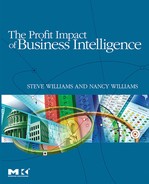Appendix A A business intelligence glossary
This appendix defines the most important business intelligence and other technical terms used in this book.
Balanced scorecard: A strategic management system that connects activities to strategic goals and measures how much the activities contribute to achieving those goals. It provides a broader view of the business than merely looking at financial data. Devised by management theorists Robert Kaplan and David Norton.
BI Pathway: A business-centric approach to designing and implementing BI that explicitly connects BI program initiatives with the organization’s needs, readiness, strategic goals, and return on investment (however measured).
Business-centric: Methods that design return on investment into BI initiatives from the outset and systematically drive the use of BI into the core business processes and decisions that determine business results. Business-centric methods go beyond traditional approaches by putting rigor into defining the business value capture mechanism for each BI project.
Business information: Sets of data presented in a business context that are about a business and its environment.
Business intelligence (BI): Business information and business analyses within the context of key business processes that lead to decisions and actions and which result in improved business performance.
Business question: A question (i.e., a business requirement) that provides details of business users’ information needs.
Business value capture mechanism: The manner in which business processes and key decision processes must change in order to leverage BI investments, which are managed as a portfolio. This also includes using process reengineering and process improvement techniques to ensure that BI projects actually deliver the intended ROI.
Customer relationship management (CRM): The tracking and management of all the organization’s interactions with its customers in order to provide better service, encourage customer loyalty, and increase the organization’s long-term profit per customer.
Data: Facts (such as measurements, statistics, names, categories, etc.) recorded or stored and used as a basis for reasoning, discussion, or calculation.
Data cleansing: The removal of inconsistencies, errors, and gaps in source data prior to its incorporation into data warehouses or data marts to facilitate data integration and improve data quality.
Data mart: A data structure that is optimized for access. It is designed to facilitate end-user analysis of data. It typically supports a single, analytic application used by a distinct set of workers. (Standard definition from The Data Warehousing Institute)
Data warehouse: A data structure that is optimized for distribution. It collects and stores integrated sets of historical data from multiple operational systems and feeds them to one or more data marts. (Standard definition from The Data Warehousing Institute)
Extract, transformation, and loading (ETL): Data Warehouse process that extracts data from source systems, potentially changes it (transformation process), and loads it into target data stores in the BI/DW environment.
Fact/qualifier matrix: A technique to (partially) model target data at a conceptual level. Consists of facts (discrete items of business information that users need from the data warehouse), qualifiers (criteria or data items needed to group, sequence, select, and access facts for presentation to a data warehouse user), and associations (intersecting cells in the matrix that show how qualifiers are related to the facts). (Standard definition from The Data Warehousing Institute)
Information: Sets of data presented in a context. Information about a business and its environment.
OLAP: Online analytical processing. Programmatic analysis of data warehouse or data mart data to yield actionable business intelligence.
OLTP: Online transaction processing. Real-time programmatic processing for operational (rather than analytical) purposes, such as recording a bank customer’s deposit at an automated teller machine or tracking a new customer order.
Program: A set of projects pointed toward the same objective.
Project: A formal commitment of resources to deliver known results by a specified time. (Standard definition from The Data Warehousing Institute)
Return on investment (ROI): The full potential business value of an investment.
Supply chain management (SCM): The practice of designing and optimizing supply chain business processes to provide superior service to those customers who drive the bulk of one’s profit.
